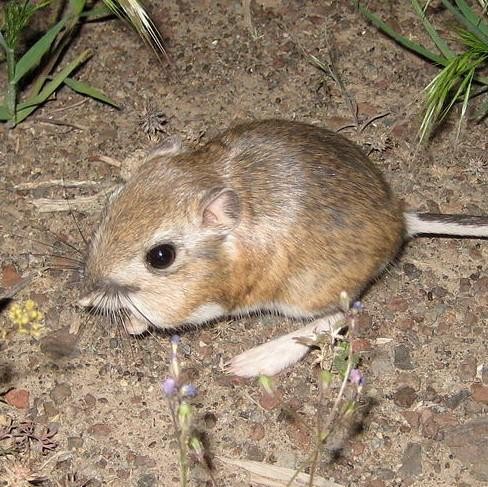Kangaroo rats, scientifically known as Dipodomys, are undeniably fascinating creatures. Their hopping gait and oversized tails immediately set them apart in the rodent world, sparking curiosity about their potential as pets. Native to the arid landscapes of North America, these small mammals have adapted to survive in harsh conditions, leading some to wonder if they could thrive in a home environment. But before you envision a kangaroo rat joining your family, it’s essential to delve into the realities of keeping these unique animals as pets. Are they truly suitable for domestication, or is their wild nature too demanding for the average pet owner? Let’s explore the world of kangaroo rats and uncover the truth about their pet potential.
Understanding the Unique Nature of Kangaroo Rats
Kangaroo rats are more than just rodents with an unusual appearance. Their physical characteristics and natural behaviors are intricately linked to their desert habitat. These adaptations are crucial to consider when thinking about keeping them as pets. Unlike typical pet rodents like hamsters or guinea pigs, kangaroo rats are built for a life of extensive burrowing, high-speed hopping, and minimal water intake.
Their powerful hind legs allow them to leap up to nine feet, an incredible feat for such a small animal, primarily used to evade predators in the wild. This inherent need for space and movement is a far cry from the confined environments suitable for many common pocket pets. Furthermore, kangaroo rats are nocturnal creatures, meaning they are most active during the night and sleep during the day. This nocturnal nature can impact their interaction with owners who are typically active during daylight hours. Understanding these fundamental aspects of their biology is the first step in determining if keeping a kangaroo rat as a pet aligns with responsible pet ownership.
Is a Kangaroo Rat a Good Pet Choice? Examining the Challenges
While their unique charm is undeniable, the question of whether kangaroo rats make good pets is complex. The reality is that keeping a kangaroo rat happy and healthy in captivity presents significant challenges that may outweigh the appeal for most potential owners.
One of the primary concerns is their need for space. Kangaroo rats are naturally active animals that thrive on movement. Confining them to a small cage, even a large one by rodent standards, can be detrimental to their well-being. They require ample room to run, hop, and express their natural digging behaviors. Replicating a suitable environment would likely necessitate a very large enclosure, potentially even an entire room or a custom-built outdoor space, securely fenced to prevent escapes.
Diet is another critical factor. In the wild, kangaroo rats primarily feed on seeds, grains, and some insects. Replicating this specialized diet in captivity can be difficult. They require a specific balance of nutrients, and providing an inappropriate diet can lead to health problems. Sourcing the correct types of seeds and ensuring they are of high quality can be an ongoing challenge.
Furthermore, kangaroo rats are not naturally social animals in the way that some pets are. While they may live in colonies in the wild, they are not necessarily animals that seek out companionship with humans or even other kangaroo rats in a confined setting. Forcing social interaction can cause stress. They are more likely to be observed than interacted with, which may not fulfill the expectations of someone seeking a cuddly or interactive pet.
Sourcing a Kangaroo Rat: Legality and Ethical Considerations
If, after understanding the challenges, you are still considering a kangaroo rat as a pet, it’s crucial to address the ethical and legal aspects of acquiring one. Taking a kangaroo rat from the wild is strongly discouraged and often illegal. Wild animals are adapted to their natural environment and removing them can cause immense stress and potentially lead to their death, even before considering the ecological impact.
Legitimate breeders of kangaroo rats are extremely rare, if they exist at all. The original article rightly points out the importance of CITES certification when dealing with exotic animals, but it’s highly unlikely to find a CITES-certified breeder for kangaroo rats because they are not commonly traded as pets. Any private seller should be approached with extreme caution, as they may be involved in illegal wildlife trade.
Adoption from a shelter or rescue organization might be a slightly more ethical route, although it’s still uncommon to find kangaroo rats in shelters. However, if you do encounter one needing a home, be fully prepared to meet its complex needs and understand why it might have been abandoned in the first place. The scarcity of legitimate sources underscores the fact that kangaroo rats are not domesticated animals bred for companionship.
Creating the Right Environment: Kangaroo Rat Habitat Essentials
For those determined to provide a home for a kangaroo rat, creating a suitable habitat is paramount. Mimicking their natural desert environment as closely as possible is key to their well-being.
Enclosure Size and Substrate: A spacious enclosure is non-negotiable. The floor space should be maximized to allow for running and hopping. A deep layer of sand or a sand-soil mixture is essential for digging and burrowing, mimicking their natural behavior and providing insulation. The enclosure should be secure, with a tightly fitting lid and strong walls to prevent escapes, as they are agile jumpers and diggers.
Temperature and Lighting: Kangaroo rats are adapted to arid climates and require warm temperatures. The enclosure should be kept within a temperature range of 70-80°F (21-27°C). Natural sunlight is beneficial, but direct, intense sunlight should be avoided. Since they are nocturnal, a regular day-night cycle is still important for their overall health.
Enrichment and Burrowing Opportunities: Beyond space, enrichment is crucial. Provide tunnels, rocks, and branches to simulate their natural environment and encourage exploration. Deep substrate for burrowing is not just enrichment, it’s a fundamental need. They create burrows for shelter, food storage, and temperature regulation.
Dietary Needs in Detail: A specialized seed-based diet is the cornerstone of kangaroo rat care. A mix of small seeds, grains, and dried legumes is appropriate. Supplementing with small amounts of dried insects can also be beneficial. Fresh water is generally not required as they obtain moisture from their food, but a small water dish can be offered, especially if the humidity is low. Avoid sugary treats or fruits, as these are not part of their natural diet and can cause digestive issues.
Understanding Kangaroo Rat Behavior as Pets
Even in a well-designed habitat, understanding kangaroo rat behavior is essential for realistic expectations. They are not animals that will typically enjoy handling or direct interaction. Their wild instincts remain strong, and they are naturally skittish and easily stressed by human interaction.
Observing them is the primary form of “interaction” you will have. Setting up their enclosure in a quiet area where you can observe their nocturnal activities can be rewarding for those who appreciate observing animal behavior. However, if you are looking for a pet that you can cuddle, play with, or train, a kangaroo rat is not a suitable choice.
Their sensitivity to noise and vibrations should also be considered. Loud noises or sudden movements can startle them. A calm and quiet environment is best to minimize stress. While they may become accustomed to your presence over time, they are unlikely to ever become truly “tame” in the way domesticated pets are.
Conclusion: Reconsidering the Kangaroo Rat as a Pet
In conclusion, while the idea of keeping a kangaroo rat as a pet might be intriguing, the reality is that they are far from ideal companion animals for most people. Their specialized needs for space, diet, and environment, combined with their wild nature and limited interaction with humans, make them challenging pets to keep responsibly.
For those fascinated by these unique rodents, appreciating them in their natural habitat or supporting conservation efforts is a far more ethical and sustainable approach. If you are seeking a pet rodent that offers companionship and interaction, consider domesticated rats, hamsters, or gerbils, which have been bred for generations to thrive in human care and enjoy interacting with their owners. The allure of the exotic should not outweigh the responsibility of providing appropriate care and respecting the wild nature of animals like the kangaroo rat.

